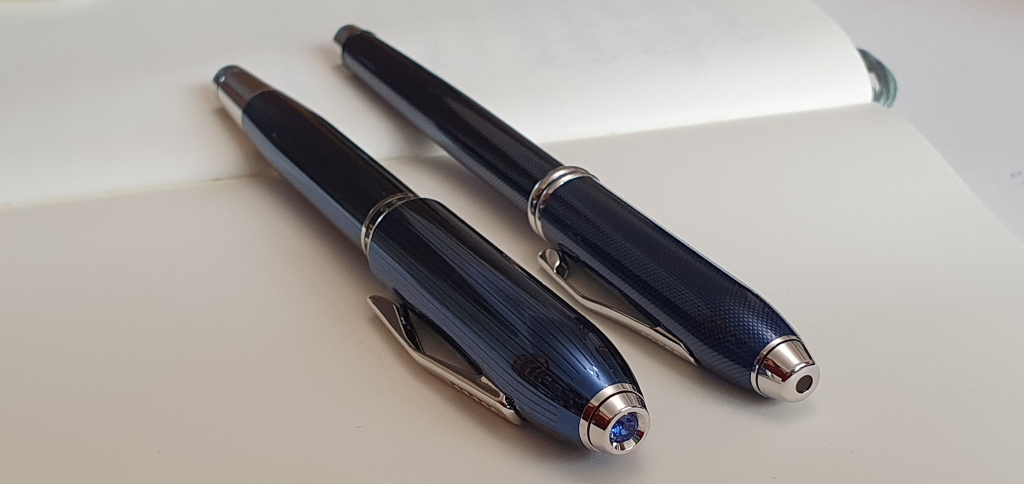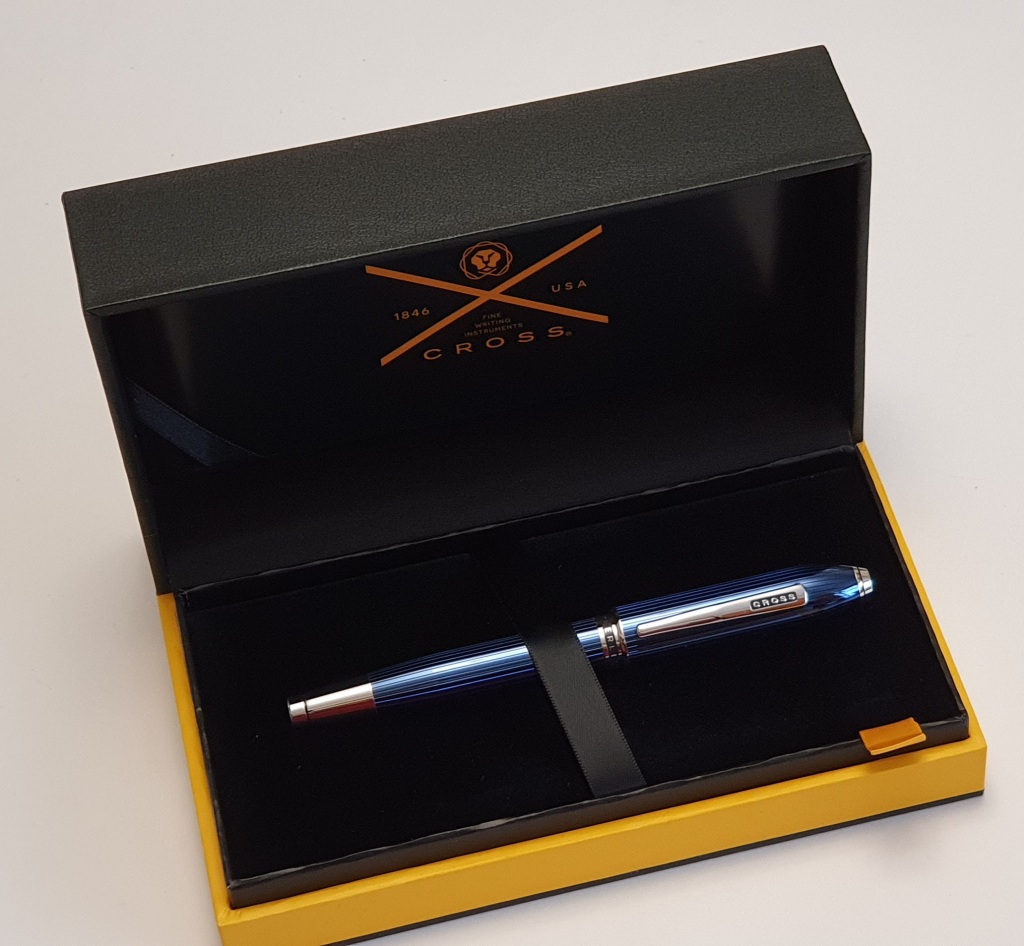I feel very fortunate, to have derived so much enjoyment from my fountain pen hobby for another year. It has been a different year in many ways – no pen shows or pen club meets since March, no journaling on foreign holidays or discovering interesting pen shops overseas – but there have been plenty of other compensations.
Acquisitions.
I spent far less money on fountain pens this year. I acquired 16 pens of which six were given to me leaving 10 which I bought for myself. I began the year with a hope of becoming “fountain pen neutral” – selling or giving away as many pens as I bought. This did not happen although I did give away five and sell one. The sale was of my Delta Fantasia Vintage in dark green celluloid, one of only 25 made in that colour. The sale came about as a fortuitous bit of matchmaking by my friend Jon, of pensharing.com who saw on Instagram that someone was looking for this model. Knowing I had one, he put us in touch. My Delta has now been rehomed to Taiwan.
Taking account of this sale, my total net spend on fountains this year was a comparatively frugal £499, a healthy reduction on last year’s £2,000.
Pen favourites of 2020.
It was the same Jon who alerted me to an event in February at the delightful London stationery shop, Choosing Keeping, for the launch of the Platinum Curidas, an exciting new retractable fountain pen from Japan, before they were available from other dealers here. I bought one. I loved how it wrote and the rather intricate way of filling the pen, but found it more comfortable with the metal pocket clip removed. The clip was detachable but this left a keel-like bump of acrylic, making it impossible for me to grip the pen comfortably. After a few days, I filed it off. This act and my blog post about it brought me to the attention of The Pen Addict podcast and I got a surprise mention in Episode 399. I think it is a terrific pen although I am aware that some people had problems of the feed cracking beneath the nib.
After buying the Curidas I bought my first Pilot Capless in the stealthy matte black finish with a medium nib. The nib is a joy. It is a remarkable pen but again, for my lefty overwriter style the clip is in my way. I can use it in underwriter mode. In overwriter mode, I cannot rotate the nib to the paper as I normally would to find the sweet spot, but the 18k nib is so soft and forgiving that it writes almost as well. I would still prefer it without the clip. I have read up on the “clipectomy” procedure but this requires tools and is rather more tricky than I can do myself.
I am still discovering what I like and what I do not like in a fountain pen. I have said before, that it is nice to be able to use and experience pens of all shapes and types. But this year I was given a Diplomat Excellence A Plus by my wife for my birthday and it is one of those pens that feels just the right size, shape and weight for me and also has a superb steel nib (a fine) which is smooth and firm. I enjoy picking it up every day for my diary.
Another pen which is similar to the Diplomat and equally comfortable is the Cross Peerless 125 but with an 18k gold nib made by Sailor. The quartz blue model is both gorgeous to look at and to hold! This year I also bought my first Sailor Pro-Gear classic and later, a 1911 standard, having been so impressed by the Pro-Gear Slim that I acquired last year.

Favourite inexpensive pens of 2020.
I still have a weakness and optimism for inexpensive pens. This year’s intake included a Lamy Nexx, Waterman Allure, Faber-Castell Hexo and a Jinhao 159. I was given a Platinum Prefounte and converter, with a fine 0.3mm nib which is a very useful addition. My most successful find was the Moonman S5, clear demonstrator eyedropper pen which comes with three nib units. One of these was an oblique which I found beautifully smooth and enjoyable and flattering to my handwriting. I have learned this year that for me, (speaking as a lefty overwriter), pens fall into two categories: there are those that make you adjust your grip and your handwriting to conform to them: the Pilot Capless and the Lamy Safari are examples. Then there are other pens that conform to the way I write and bring out the best in my writing: the Moonman S5 with oblique nib is an example of this. It has nothing to do with price.

Other highlights.
Having additional time at home during the lockdown allowed me more time for pen-related activities. I acquired a set of brass shims and set about trying to improve a few problem nibs. The most notable success was with my Aurora 88, a stunning pen which should be the pride and joy of my accumulation but which wrote rather more fine and dry than I liked. With a few minutes of tweaking and a fortuitous bit of controlled recklessness (which included wriggling a craft knife blade between the 14k gold tines) I was able to transform the nib into a slightly wetter and more truly “medium” but still smooth writer, which I now love using.
During this strange time I was able to be a bit more productive with the blog. Whilst on furlough from work from April to June inclusive, I published 16 posts. The blog has been a lifeline – a source of satisfaction, relaxation and enjoyment and a bit of escapism I suppose, during the troubling year. I enjoy receiving comments and am always glad and flattered to be asked for help from readers on their pen-related issues. Two separate readers both had the same problem of being unable to fit a converter in the barrel of a new Cross Bailey Light: the solution was to remove the supplied second cartridge which gets wedged tight in the back! Questions about the best starter fountain pen, or a suitable good fountain pen for a Christmas gift are often harder to answer than you might think but I do my best.
With pen club meets disbanded, there have been a few Zoom meetings to catch up and to talk pens, although of course without being able to try each other’s. It has been good to keep in touch in this way, with a few pen friends from Instagram as well.
Personally though, I feel better able to marshal my thoughts in a letter and I have enjoyed some old fashioned pen and ink correspondence with pen friends here and abroad over the year. For the latter, I write the letter by hand and then scan and send it by email.
Another writing project has seen me copying out Marcus Aurelius’ book “Meditations” in my pseudo-typewriter font style of underwriting. I enjoy reading and copying the text and changing pens after every two page spread. I am about three quarters of the way through.
Conclusions.
So, that was my year in pens. Thanks once again to my fellow bloggers, correspondents and instagrammers for their friendship. My year ended as it began with surprise gifts from my pen friend in Australia. In January I received two lesser-spotted Pelikans: a “P55 Future” and a “Go!” neither of which I knew about and I have enjoyed trying them. Then a few days ago, I was given the pre-loved Graf von Faber-Castell Classic Anello, which I had been keeping until such a time as he could get over to collect it. I am yet to match such feats of generosity. But I am learning that the pursuit of even more pens for oneself, as a path to happiness, is destined to be endless and doomed to failure. The real trick is to learn contentment with, and to enjoy using fully, what you have.






